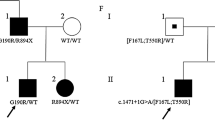Summary
Paramyotonia congenita (PC), an autosomal dominant non-progressive muscle disorder, is characterised by cold-induced stiffness followed by muscle weakness. The weakness is caused by a dysfunction of the sodium channel in muscle fibre. Parts of the gene coding for the α-subunit of the sodium channel of the adult human skeletal muscle (SCN4A) have been localised on chromosome 17. To investigate the role of this gene in the etiology of PC, a linkage analysis in 17 well-defined families was carried out. The results (z=20.61, Θ=0.001) show that the mutant gene responsible for the disorder is indeed tightly linked to the SCN4A gene. The mutation causing hyperkalemic periodic paralysis (HyperPP) with myotonia has previously been mapped to this gene locus by the same candidate gene approach. Thus, our data suggest that PC and HyperPP are caused by allelic mutations at a single locus on chromosome 17.
Similar content being viewed by others
References
Becker PE (1970) Paramyotonia congenita (Eulenburg). (Fortschritte der allgemeinen und klinischen Humangenetik). Thieme, Stuttgart
Becker PE (1977) Myotonia congenita and syndromes associated with myotonia. (Topics in human genetics) Thieme, Stuttgart
Chakravarti A, Phillipps JA, Mellitis KH, Buetow KH, Seeburg PH (1984) Patterns of polymorphisms and linkage disequilibrium suggest independent origins of the human growth hormone gene cluster. Proc Natl Acad Sci USA 81:6085–6089
De Silva SM, Kuncl RW, Griffin JW, Cornblath DR, Chavoustie S (1990) Paramyotonia congenita or hyperkalemic periodic paralysis? Clinical and electrophysiological features of each entity in one family. Muscle Nerve 13:21–26
Engel AG (1986) Periodic paralysis. In: Engel AG, Banker BO (eds) Myology. McGraw-Hill, New York, pp 1843–1870
Eulenburg A (1886) Über eine familiäre, durch 6 Generationen verfolgbare Form congenitaler Paramyotonie. Neurol Zentralbl 5:265–272
Fontaine B, Khurana TS, Hoffman EP, Bruns GAP, Haines JL, Trofatter JA, Hanson MP, Rich J, McFarlane H, McKenna Yasek D, Romano D, Gusella JF et al (1990) Hyperkalemic periodic paralysis and the adult muscle sodium channel α-sub-unit gene. Science 250:1000–1002
Gamstorp I (1956) Adynamia episodica hereditaria. Acta Paediatr 45 [Suppl 108]: 1–126
Gamstorp I (1963) Adynamia episodica hereditaria and myotonia. Acta Neurol Scand 39:41–58
George AL, Ledbetter DH, Kallen RG, Barchi RL (1991) Assignment of a human skeletal muscle sodium channel α-subunit gene (SCN4A) to 17q23.1–25.3. Genomics 9:555–556
Harper PS (1989) Myotonic dystrophy. Saunders, London
Koch MC, Ricker K, Otto M, Grimm T, Hoffmann EP, Rüdel R, Bender K, Zoll B, Harper PS, Lehmann-Horn F (1991) Confirmation of linkage of hyperkalemic periodic paralysis to chromosome 17. J Med Genet 28:583–586
Lathrop GM, Lalouel JM, Julier C, Ott J (1984) Strategies for multilocus linkage analysis in humans. Proc Natl Acad Sci USA 81:3443–3446
Lehmann-Horn F, Rüdel R, Dengler R, Lorkovic H, Haass A, Ricker K (1981) Membrane defects in paramyotonia congenita with and without myotonia in a warm environment. Muscle Nerve 4:396–406
Lehmann-Horn F, Rüdel R, Ricker K, Lorkovic H, Dengler R, Hopf HC (1983) Two cases of adynamia episodica hereditaria: in vitro investigation of muscle membrane and contraction parameters. Muscle Nerve 6:113–121
Lehmann-Horn F, Rüdel R, Ricker K (1987a) Membrane defects in paramyotonia congenita (Eulenburg). Muscle Nerve 10: 633–641
Lehmann-Horn F, Küther G, Ricker K, Grafe P, Ballanyi K, Rudel R (1987b) Adynamia episodica hereditaria with myotonia: a non-inactivating sodium current and the effect of extracellular pH. Muscle Nerve 10:363–374
Lehmann-Horn F, Iaizzo PA, Hatt H, Franke C (1991) Altered gating and reduced conductance of single sodium channels in hyperkalemic periodic paralysis. Pflügers Arch 418:297–299
Miller SA, Dykes DD, Polesky HF (1988) A simple salting out procedure for extracting DNA from human nucleated cells. Nucleic Acids Res 16:1215
Moxley RT, Ricker K, Kingston WJ, Böhlen R (1989) Potassium uptake in muscle during paramyotonic weakness. Neurology 39:952–955
Rich EC (1894) A unique form of motor paralysis due to cold. Med News 65:210–213
Ricker K, Rohkamm R, Bohlen R (1986) Adynamia episodica and paralysis periodica paramyotonica. Neurology 36:682–686
Ricker K, Camacho LM, Grafe P, Lehmann-Horn F, Rudel R (1989) Adynamia episodica hereditaria: what causes the weakness? Muscle Nerve 12:883–891
Ricker K, Lehmann-Horn F, Moxley RT (1990) Myotonia fluctuans. Arch Neurol 47:268–272
Rüdel R, Lehmann-Horn F (1985) Membrane changes in cells from myotonia patients. Physiol Rev 65:310–356
Serratrice G, Desnuelle C (1982) Paramyotonie congenitale, adynamie episodique hereditaire ou paralysie periodique familiale paramyotonique et hyperkaliemique. Semin Hop Paris 58: 841–848
Thrush DC, Morris DJ, Salmon MV (1972) Paramyotonia congenita: a clinical, histochemical and pathological study. Brain 95:537–552
Author information
Authors and Affiliations
Additional information
Dedicated to Professor P. E. Becker on the occasion of his 83rd birthday.
Rights and permissions
About this article
Cite this article
Koch, M.C., Ricker, K., Otto, M. et al. Linkage data suggesting allelic heterogeneity for paramyotonia congenita and hyperkalemic periodic paralysis on chromosome 17. Hum Genet 88, 71–74 (1991). https://doi.org/10.1007/BF00204932
Received:
Revised:
Issue Date:
DOI: https://doi.org/10.1007/BF00204932




